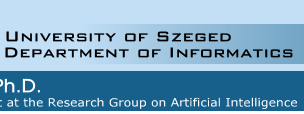|
|
Classifier Combination in Speech Recognition
Felföldi László, András Kocsor, László
Tóth
In statistical pattern recognition [1][2]
the principal task is to classify abstract data sets. Instead of using robust
but computational expensive algorithms it is possible to combine 'weak'
classifiers which can be employed solving complex classification tasks.
Different classifiers trained on the same data set have different local
behavior; each may have its own region in the feature space where it performs
better than the others. It is also possible to train the same type of classifiers
on various training sets having same characteristics probability distribution
or feature spaces. To obtain the best possible separations, a combination
of techniques may be used.
A fair number of combination schemes have been proposed in the
literature [3], these schemes differing from each other in
their architecture, the characteristics of the combiner, and the
selection of the individual classifiers. In this comparative study
we will examine the effectiveness of the commonly used hybrid
schemes - especially for speech recognition problems -
concentrating on cases which employ different combination of
classifiers. Out of the algorithms available we chose the
currently most frequently used classifiers: artificial neural
networks, support vector machines [1], decision tree
learners and Gaussian mixture models.
References
- [1]
- Vapnik, V. N., Statistical Learning Theory, John Wiley
& Sons Inc., 1998.
- [2]
- R. O. Duda, P. E. Hart And D. G. Stork, Pattern Classification,
John Wiley & Sons Inc., 2001.
- [3]
- A. K. Jain, Statistical Pattern Recognition: A Review, IEEE
Trans. Pattern Analysis And Machine Intelligence, Vol. 22. No. 1, January
2000.
|
|





